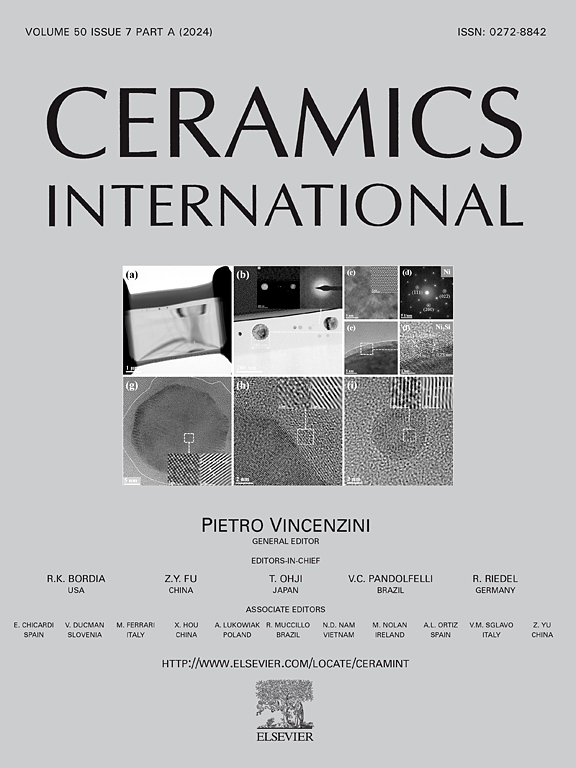Enhanced luminescence in Eu3+-doped glass-ceramic derived from black talc: A novel approach for advanced W-LED lighting applications
IF 5.1
2区 材料科学
Q1 MATERIALS SCIENCE, CERAMICS
引用次数: 0
Abstract
In the realm of advanced luminescent materials, glass-ceramic (GC) incorporated into rare earth (RE) represents a promising candidate. However, their practical application has been constrained by limitations in luminescence efficiency and thermal stability. This study overcomes these challenges by introducing a novel Eu3+-doped black talc GC with enhanced optical characteristics. Our method involved fabricating a new glass matrix and incorporating heavy concentrations of Eu3+ ions. Following a precise nucleation-crystallization process, CaMgSi2O6 nanoscale crystals were uniformly dispersed within the GCs matrix, markedly enhancing its luminescent properties. When excited by 394 nm light, this GC achieved a notable internal quantum efficiency (IQE) of 88.97 %, surpassing many traditional Eu3+-doped glasses and GCs. Furthermore, it retained 89.6 % of its luminescence intensity even at 100 °C, indicating remarkable thermostability. To validate the GC's practical utility, we integrated this material into a white light-emitting diode (W-LED) component, incorporating a LED chip, CaMgSi2O6: Eu3+ GC, BaMgAl10O17: Eu2+, and Ba2SiO4: Eu2+ phosphor. The fabricated device demonstrated excellent chromaticity coordinates of (0.3493, 0.3935), a correlated color temperature (CCT) of 4976K, and a prominent color rendering index (CRI) of 90.3. This research not only expands the potential applications of black talc, but the prepared GCs also exhibit excellent performance in luminescence properties, highlighting the broad application of this Eu3+-doped GCs in W-LED lighting technology.
求助全文
约1分钟内获得全文
求助全文
来源期刊

Ceramics International
工程技术-材料科学:硅酸盐
CiteScore
9.40
自引率
15.40%
发文量
4558
审稿时长
25 days
期刊介绍:
Ceramics International covers the science of advanced ceramic materials. The journal encourages contributions that demonstrate how an understanding of the basic chemical and physical phenomena may direct materials design and stimulate ideas for new or improved processing techniques, in order to obtain materials with desired structural features and properties.
Ceramics International covers oxide and non-oxide ceramics, functional glasses, glass ceramics, amorphous inorganic non-metallic materials (and their combinations with metal and organic materials), in the form of particulates, dense or porous bodies, thin/thick films and laminated, graded and composite structures. Process related topics such as ceramic-ceramic joints or joining ceramics with dissimilar materials, as well as surface finishing and conditioning are also covered. Besides traditional processing techniques, manufacturing routes of interest include innovative procedures benefiting from externally applied stresses, electromagnetic fields and energetic beams, as well as top-down and self-assembly nanotechnology approaches. In addition, the journal welcomes submissions on bio-inspired and bio-enabled materials designs, experimentally validated multi scale modelling and simulation for materials design, and the use of the most advanced chemical and physical characterization techniques of structure, properties and behaviour.
Technologically relevant low-dimensional systems are a particular focus of Ceramics International. These include 0, 1 and 2-D nanomaterials (also covering CNTs, graphene and related materials, and diamond-like carbons), their nanocomposites, as well as nano-hybrids and hierarchical multifunctional nanostructures that might integrate molecular, biological and electronic components.
 求助内容:
求助内容: 应助结果提醒方式:
应助结果提醒方式:


